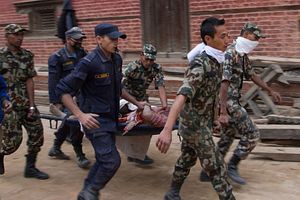Saturday’s earthquake in Nepal, registered at magnitude 7.8 by the U.S. Geological Survey, has devastated the country, leaving at least 3,617 dead. The death toll is expected to continue to rise as rescue teams make their way to remote villages where damage is feared to be extensive. Survivors, meanwhile, must cope with shortages of basic necessities — food, water, shelter, and medical supplies.
Amidst the devastation, Nepal’s government is looking to the international community to provide desperately needed aid. In particular, Kathmandu will need help from its two powerful neighbors, India and China. China in particular, which is trying to bolster its presence in South Asia through the “One Belt, One Road” initiative, will find its actions heavily scrutinized by people wondering if China is really ready to play the role of a great power.
China, well-versed in earthquake rescue and relief efforts from its own tragic experiences, moved quickly to respond. China’s first rescue team, consisting of 62 people (“40 rescuers, 10 medical workers, and 12 seismic experts,” according to Xinhua) and six sniffer dogs, arrived in Nepal on Sunday. A separate 58-member medical team followed on Monday, bringing with them 13 tons of medical aid.
The PLA has also dispatched 55 soldiers (plus four rescue dogs, recovery vehicles, and rescue equipment) to Nepal on board a IL-76 transport plane. Another 45 soldiers are expected to head to Nepal on Tuesday. In all, a total of 170 PLA soldiers will be sent to Nepal as rescue and medical teams, China’s Foreign Ministry said on Monday. That makes this already one of China’s largest disaster relief operations conducted on foreign soil.
China’s government has pledged to provide 20 million RMB ($3.3 million) worth of material aid, “including tents, blankets, and generators,” Xinhua said. “The first 186 tons of emergency supplies from the Chinese government … will be delivered to Nepal on four different flights today and tomorrow,” Foreign Ministry spokesperson Hong Lei said.
The massive earthquake also did damage within China, although on a much smaller scale. Xinhua reports that at least 20 people were killed and 58 injured in southwestern Tibet.
In addition, China’s Embassy in Nepal has confirmed that four Chinese nationals in Nepal (two workers, one tourist, and one mountain climber) were killed in the earthquake. China’s Foreign Ministry said that there were roughly 4,000 Chinese tourists in Nepal at the time of the quake, and that Chinese airlines were actively evacuating travelers stranded in Nepal.
While the race is on to help rescue as many survivors from the rubble as possible, the rebuilding process in Nepal will be a marathon, not a sprint. Recovery efforts are likely to take years – at least three to five years, according to one estimate — and cost anywhere from $5 billion to $20 billion. And continuing aftershocks mean the damage to buildings and infrastructures isn’t done yet, as Hun Kim of the Asian Development Bank told the Wall Street Journal.
This lengthy rebuilding process won’t gain as many headlines as relief efforts in the immediate aftermath of the disaster, but will have a dramatic impact on Nepal’s future. China, which already emphasizes infrastructure building as part of its “One Belt, One Road” project, has a major role to play in helping rebuild Nepal over the coming years.

































